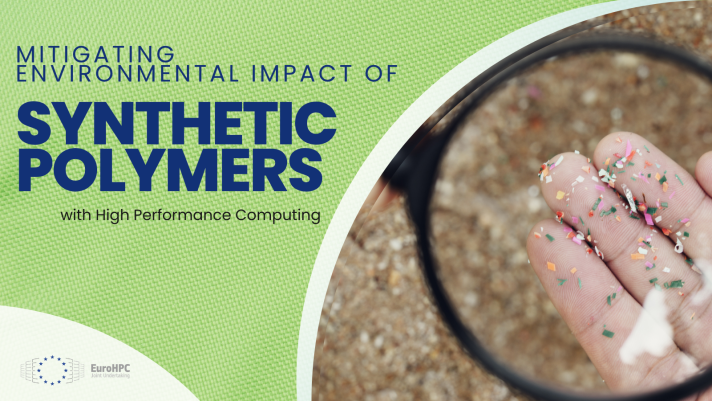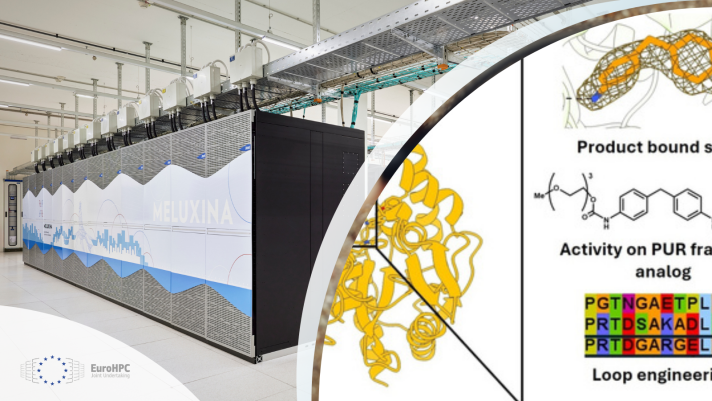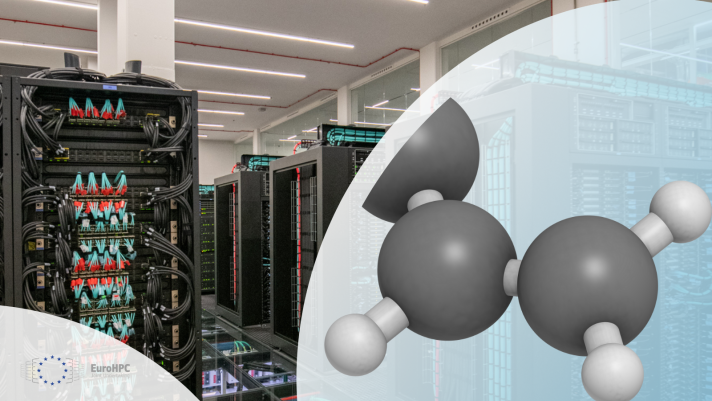Plastic is everywhere—in our homes, our oceans, our bodies, and even in the air we breathe. Plastic revolutionised modern life, providing a cheap, durable material that has everyday and industrial applications. As convenient as plastic products may be, our reliance on them has created an environmental crisis that has become one of the defining challenges of our time.
Two EuroHPC JU awarded projects are working on solving the issues arising from increasing plastic consumption. One project is focused on creating new durable, biodegradable materials to replace plastic. The other is investigating methods for more effective ways to process industrial plastic waste. These research projects offer tangible solutions to better manage the environmental crisis related to plastics.
Plastics = Polymers
Plastic is an umbrella term used to describe a variety of synthetic polymers; large molecules made up of repeating subunits called monomers that are chemically bonded together in long chains. These polymers are like molecular necklaces, with each bead representing a simpler chemical compound. This chain-like structure gives plastics their remarkable properties: flexibility, durability, and resistance to degradation. These traits are also the precise qualities that make plastics such a challenge to remove from the environment.
Unlike natural materials, plastics resist natural breakdown processes. For example, a plastic water bottle will persist in the environment for 450 years or more. Globally we produce over 400 million metric tons of plastic each year—equivalent to the weight of the entire human population.
Only a small percentage of plastic is recycled; the rest ends up in landfills, in the oceans, or scattered across our landscapes. Microplastics are created when larger plastic items break down into tiny, microscopic pieces and they are now abundant in our environment. Recent studies have found microplastics in our tap water (83% of samples worldwide contain microplastics), table salt, and even in liquids like beer. The average person now ingests approximately 5 grams of microplastic each week—roughly the weight of a credit card.
Scientific solutions powered by HPC
Two projects awarded computational hours by EuroHPC JU are focused to mitigate the environmental impact of synthetic polymers.
Enzymes break it down...
Professor Maria João Ramos and her team were awarded 130,000 node hours on the supercomputer Meluxina to undertake research targeting newly discovered polyester-degrading enzymes. Enzymes are everywhere, and play an essential role in speeding up chemical reactions. In our bodies, for example, they are an important part of breaking down food during digestive processes. Because plastic breaks down very slowly, research targeting new enzymes could provide more efficient ways to accelerate the degradation process.
For this project, a team of researchers from across Portugal are working together to enhance the catalytic efficiency of enzymes that degrade polyester, which at the moment is not fast enough for industrial manufacturing purposes. As a result, unsaturated polyesters are a key contributor to global plastic pollution.
The research involves calculations that are very computationally demanding and cannot be performed without access to supercomputers like Meluxina. Hybrid methods (QM/MM - quantum mechanics/molecular mechanics) were used for the elucidation of catalytic mechanisms in this research. This approach can enable rational enzyme engineering—for example, by applying the transition-state-stabilising macrodipole model to enhance turnover rates. Additionally, structural and computational analyses of the polyurethane-degrading amidases SP2 and SP3 have not only uncovered their catalytic mechanisms but identified potential pathways for improving the biodegradation of polyether-based polyurethanes too.
Ongoing and future work focuses on enhancing the catalytic activity of the described enzymes, discovering new plastic-degrading enzymes, and guiding their rational optimisation to improve catalytic efficiency and substrate scope. The team behind this research has already published multiple academic papers showcasing their results and will present them during the parallel session on material sciences and solid-state physics at the EuroHPC User Days 2025 in Copenhagen.
Biodegrading unsaturated polyesters
Could biopolymers save the day?
Nextmol is a computational chemistry company based in Spain who are dedicated to the development of advanced modelling and AI tools for the chemical industry. A key focus for the company is to enable faster development of sustainable chemicals. In 2024, Nextmol was awarded 30,000 node hours on EuroHPC supercomputer MareNostrum 5 to employ Machine Learning (ML) to screen candidate biopolymers. Biopolymers (polymers developed from natural sources like plants) have emerged as a promising solution to replacing petrochemical polymers and reducing plastic pollution.
Current research suggests that blending biopolymers will lead to a more durable product with similar advantages to plastic. Testing thousands of possible biopolymer combinations through experimentation in a science lab is slow, costly and inefficient. High-performance computing provides an excellent route to finding a solution more quickly.
With the ability to perform 314 billion calculations per second, MareNostrum 5 has the compute power to allow the research scientists from Nextmol rapidly create essential datasets. Nextmol performed high-throughput Molecular Dynamics simulations of over 500 polymers and polymer blends to generate an extended and consistent computational dataset of biopolymer properties that has subsequently been used for the training of a predictive Machine Learning model.
Nextmol will continue to build on the discoveries from this project and the data and Machine Learning model will be utilised to further determine structure-property relationships of biopolymers and for analyses of synergistic/antagonistic effects. Data produced from this research will be used to create new biopolymers with the potential to deliver sustainable alternatives to petroleum-based plastics.
Nextmol will also be presenting at the EuroHPC User Days 2025, during the Chemical Sciences parallel session on Day 1 of the event.
CoSSPIA – Computational Screening of Sustainable Polymers for Industrial Applications
Breaking up with plastic
Scientific solutions are needed to transform one of our most used materials into something far more sustainable. By supporting this cutting-edge research, EuroHPC JU is contributing to the goals of the European Commission to change the way plastic products are designed, produced, used and recycled. Since we know plastic can persist in the environment for hundreds, and in some cases thousands of years, EuroHPC infrastructure is essential to supporting scientific solutions to address the mountains of plastic clogging up our planet.




